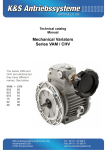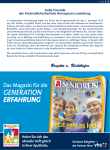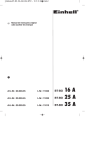Download Operating Instructions Thread Rolling Heads F 001, F
Transcript
Head in fixed application (for F and K types): The front part of the head is turned by using the handle (25) with the ball (23) (if used on automatics, closing is accomplished by using closing roller over a cam) until the coupling rests between the spring housing (2) and shank (1). Head in rotating application (only for K 01 -1): The front part of the head is slowed down in its revolving motion by using an additional yoke with brake shoes, the front part is then turned against the shank until the coupling rests between the spring housing (2) and the shank (1). Machining of the component: Starting diameter d2 to be thread rolled must be the equivalent to the effective diameter. Deviations are possible, depending upon type of component material being used. The starting diameter arrived at now should never be increased. The components have to be chamfered under γ = 10° – 25° against the axis and must be concentric. An undercut at the thread run-out is not required. If an undercut is called for, the same should be chamfered according to sketch below. The diameter d1 must be below the root diameter of the thread. Also important is the accurate alignment of the head to the component. γ D γ d1 d2 Possible errors to be made: 1. Starting diameter selected too large or head setting too small, that means overload pressure is generated, which in most cases may be seen at the thread end by building up a bead at the thread crests over approx. the width of the rolls. 2. Chamfering (also at the undercut) is not in line with the rolling instructions. 3. Setting for length selected incorrect or component length variating (rolls are running against a shoulder). 4. Jamming of the rolls or evidence of wear on the eccentric spindles caused be heavy dirt accumulated in the coolant. 5. Unclean thread start and possible damage to the Rolls caused by incorrect teed approach at the start of rolling. 6. Damage on the Rolls or rolling of two-start threads caused by incorrect assembly of the Rolls. 7. Premature opening of the rolling head caused by the wear of the wedges for coupling in part 1 and 2. Operating Instructions Thread Rolling Heads F 001, F 01, K 01-1 γ d1 d2 D Undercut Printed in Germany, No. 0000 G (0111 1 DM/DH) Tolerance for the starting diameter: Once the accurate starting diameter, determined by a test rolling operation, has been found, then this should be considered as the maximum dimension, if the thread has been rolled just up to its crest and the effective diameter is approx. at the maximum dimension within the permissible thread tolerance. Among others the tolerance of the starting diameter is depending to what extent the thread has been rolled to. As a guide for standard threads with tolerance class 6 g the following may be used: starting diameter tolerance ≈ half effective diameter tolerance. Rolling Speed: According to component profile and spindle speeds available, the following rolling speeds are re- commended: for V-type threads approx. 20 – 60 m/min (65 – 200 ft/min) for Acme-type threads approx. 15 – 30 m/min (50 – 100 ft/min). The rolling speed is arrived at by figuring the same as tor the cutting speed. Rolling operation: The feed rate of approach should be equivalent to the pitch of thread to be rolled. After engagement over 3 – 4 thread pitches, the head itself takes over the feed movement. The support respectively the adaptor sleeve should be set-up tor easy movement in either direction at any rate. Coolants and lubricants: Recommended coolants and lubricants are those, which are also used for cutting operations, i. e. solutions with diluted ratio of 1:10 up to 1:20 – perhaps with high pressure additives – and thin cutting oils. LMT FETTE Werkzeugtechnik GmbH & Co. KG Grabauer St. 24 21493 Schwarzenbek Germany Phone +49 4151 12 - 0 Fax +49 4151 12 - 3797 www.lmt-fette.com Rolling Head-Hotline +49 4151 12 - 391 E-Mail-Hotline [email protected] www.lmt-fette.com Rolling Heads F 001, F 01 (only for fixed application) Rolling Heads K 01-1 (for fixed and rotating application) IMPORTANT: In the case of re-ordering of Spare Parts, please state Rolling Head Type and Serial-No. Please note marking on the Front Plate! S = Special angle L = Design for Left Hand Threads SL = Special angle for Left Hand Threads X...= Special design Assembly of Thread RolIs: Remove front plate (4), apply very thin coat of grease or a thin layer of MOLYKOTE to eccentric spindles (5), as well as to the inclined surfaces on front- (4) and centre plate (3). lnsert rolls (18) in the order 1-2-3 or A-B-C in clockwise direction (for left hand heads in counter-clockwise direction). Insert carbide bushing (14). Fit front plate (4) to this assembly and tighten screws. (example F 001 S) (example F 001 L) (example F 001 SL) (example F 001 X101) In case of re-ordering of Rolls, please state the Roll-Code-No., which is marked on the letter side of the Roll in addition to the dimension (e. g. for rolling head F 001 e. g. 001/...)! Adjustment of Head to thread diameter: The head is closed, i. e. the teeth of the coupling of parts 1 and 2 are in complete engagement. Parts 1 and 2 are spring loaded. First loosen three nuts (15) and insert between the rolls a screw plug gauge, or threaded sample, or if neither are available a plain plug with root diameter of the thread. The front part of the head (roller cage) is turned with the range of the three slotted holes of the spring housing (2) until the rolls (18) become fully engaged with the screw plug gauge, sample or plain plug. The three nuts (15) are then retightened. Should the effective diameter of the thread rolled not be correct, i. e. the effective diameter is too large, the three nuts (15) must be loosened and the front part of the head turned one half a calibration in the direction of the minus sign. A rolled thread should not be over rolled, or re-rolled a second time. If the length of the three slotted holes (2) is insufficient for the necessary adjustment and the zero mark “0” on the roller cage is at the ultimate minus setting, proceed as follows: 17 24 2 Spare Parts 25 9 23 1 10 7 16 3 12 8 4 24 19 11 18 22 14 13 21 5 20 6 15 No. Pcs. 1 1 Clutch or shank 2 1 Spring housing 3 1 Centre plate 4 1 Front plate 5 3 Eccentric spindles 6 3 Front Plate screw 7 1 Clutch plate 8 3 Ball lever 91) 1 Handle 10 1 Coil spring 11 3 Hardened slides 12 1 Circlip 13 3 Studs 14 3 Carbide bushing 15 3 Hexagon nut 16 1 Washer 171) 1 Hexagon nut 18 3 Thread roll 19 3 Shear pins 20 1 Stop screw body 21 1 Stop screw 22 1 Hexagon nut 231) 1 Ball 24 2 Set screw 251) 3 Washer 1) only Description Head to be adjusted to a smaller diameter: Remove the three nuts (15) and ring type washer (16). The roller cage is then drawn off and turned round 120° approx, in the direction of the minus sign. It is then re-assembled. The secondary zero marking now appears on the plus side (+) of the scale. Ring type washer (16) and nuts (15) are put on again, the head finally adjusted to correct size as per previous paragraph and nuts are tightened. It is now possible to adjust the head to a smaller diameter. Head to be adjusted to a larger diameter: Same procedure as before, but turning direction is just reversed. Adjustment of Head to thread length: Adjustment to thread length is always done when the head is in an open position, i. e. the head is opened in axial direction by disengaging the dog coupling (1 and 2). This brings the front position of the head forward corresponding to the height of the dog coupling. a) Operation with Inside Stop: Stop screw (21) is adjusted to required thread length and locked by hexagon nut (22). If the component touches the stop screw (21), the dog coupling (1 and 2) is disengaged and the head opens automatically. The unclamped length of the component is not of decisive importance here. Operation with Outside Stop: Opening operation with Outside Stop: The thread length, where chucking length is controlled, is set by a stop on the machine, which limits the forward travel of the sleeve, or the threading spindle or the turret slide. When the stop is reached, the dog coupling is disengaged and the head opens automatically. Important: As opposed to opening by means of inside stop it is in this case absolutely necessary to maintain uniform component length extending beyond the clamped portion, in case rolling is done against a shoulder or similar. for fixed application Closing of Head: When the head is closed, the rolls (18) are brought back into the rolling position.











